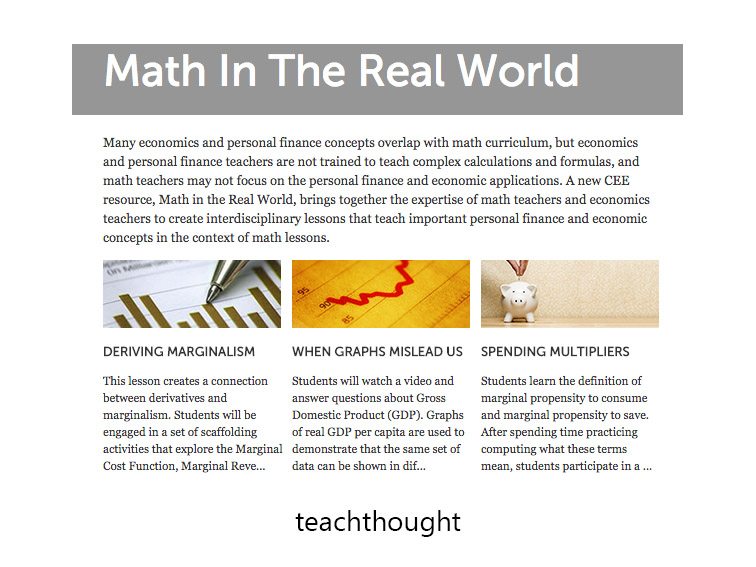400 Lessons On Math In The Real World From EconEdLink
by TeachThought Staff
NEW YORK, NY (February 19, 2015) Based on many of the same skills and concepts, math is a natural complement to economics and personal finance; and yet, they are rarely taught in conjunction with each other in our nation’s schools. The Council for Economic Education (CEE) looks to bridge that gap with their new online resource for high school teachers. With the support of sponsors Verizon, Moody’s and the Calvin K. Kazanjian Economics Foundation, CEE has developed Math in the Real World as a free and convenient tool to integrate math with economics and personal finance.
Part of EconEdLink, CEE’s free online teacher resource, Math in the Real World contains interdisciplinary lessons aimed at teaching personal finance and economic concepts in a mathematical context. Math in the Real World includes lessons that range from “Break-Even Analysis” and “Profit Maximization” to payday loan expenses and building good credit. Math in the Real World lessons are aligned with the Common Core State Standards (CCSS) in math and national standards in personal finance and economics. Lessons include activities, simulations and other tools that use current technology that promote active learning.
“As a former math major in college, I am excited that we can bring practical real-life lessons into the classroom to engage kids in three of my favorite subjects,” said Nan J. Morrison, CEO and President, CEE. “Integrating math with economics and personal finance, Math in the Real World’s lessons offer an effective way for high school teachers to cover a wide range of skills and concepts.”
The California Council on Economic Education, one of CEE’s national affiliates, recently piloted the materials with high school teachers:
“Outstanding. I especially like to attend workshops where I can instantly take materials home and implement them,” said one of the participating teachers. Another raved about its online accessibility, adding that, “its connections with other subjects will be so helpful” in her classroom.
Other Information
Many economics and personal finance concepts overlap with math curriculum, but economics and personal finance teachers are not trained to teach complex calculations and formulas, and math teachers may not focus on the personal finance and economic applications. A new CEE resource, Math in the Real World, brings together the expertise of math teachers and economics teachers to create interdisciplinary lessons that teach important personal finance and economic concepts in the context of math lessons including:
- Earning Credit: How can math help me analyze how my financial decisions today impact my credit score, interest rates and the cost of major purchases in the future?
- Inflation & Unemployment—Is There a Correlation: How does inflation correlate to unemployment?
- Cost: Rates of Change: Why is marginal cost a better metric than average cost in the decision making process?
- Profit Maximization: How can we use calculus to determine the level of output to maximize profits for a business??
- How Expensive are Payday Loans? (or The High Cost of Quick Cash): How do you determine the total cost of a payday loan?
- Break- Even Analysis: How would an entrepreneur decide whether a business is likely to be profitable?
Math in the Real World lessons are aligned with the Common Core State Standards (CCSS) in math and national standards in personal finance and economics. Lessons include activities, simulations and other tools that use current technology that promote active learning.
Math in the Real World includes 22 lessons that will be published over the next nine months.
Math In The Real World: 400 Examples, Lessons, & Resources
